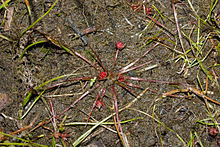Hydatellaceae
| Hydatellaceae | ||||||||||||
|---|---|---|---|---|---|---|---|---|---|---|---|---|

Trithuria australis , illustration |
||||||||||||
| Systematics | ||||||||||||
|
||||||||||||
| Scientific name | ||||||||||||
| Hydatellaceae | ||||||||||||
| U. Hamann |

The Hydatellaceae is a plant family in the order of the water lily-like (Nymphaeales) within the Bedecktsamer and since 2008 only contains one genus. The Hydatellaceae family includes only ten species that have their areas in Australia , Tasmania , New Zealand and India .
description
The species of the Hydatellaceae are annual herbaceous plants with very short stems that reach heights of growth of only 2 to 5 cm. They live submerged in fresh water or at least partially submerged in the bottom of the water anchored with roots. The alternate, spirally concentrated leaves at the base of the plant are simple, sessile, single-nerved, thread-shaped (i.e. without a discernible blade), with entire margins and 5 to 40 mm long.
They are dioecious ( dioecious ) or single- sexed ( monoecious ). Some flowers are grouped together in mostly head- shaped inflorescences . The functionally unisexual flowers are tiny and single. Bracts are missing. The male flowers contain only one fertile stamen . The female flowers usually contain only an upper carpel , a style and a stigma. Pollination takes place autogamously (autogamy = self-pollination ) or via the water ( hydrophilicity ).
There are fruit capsules formed at Trithuria or follicles or achenes in the previous Hydatella . The tiny seeds contain starch .
Systematics
The Hydatellaceae family was established by Ulrich Hamann (at the Department of Special Botany, Ruhr-Universitat Bochum) in 1975 in the New Zealand Journal of Botany , Volume 14: p. 195. The Hydatellaceae family was formerly placed in the order of the Poales . Molecular genetic investigations and a new interpretation of the morphology make it clear that the family belongs to the order of the Nymphaeales and is at the base of the genealogical tree of the Covered.
Today all species belong to the genus Trithuria .
There is only one genus with around 14 species in the Hydatellaceae family:
-
Trithuria
Hook. f. ( Syn .: Juncella F. Mueller ex Hieronymus , Hydatella Diels ): Of the approximately 14 species, eight occur in Australia and one each in New Zealand and India:
- Trithuria austinensis D.D.Sokoloff, Remizowa, TDMacfarl. & Rudall : It only occurs in Western Australia .
- Trithuria australis (Diels) DDSokoloff, Remizowa, TDMacfarl. & Rudall (Syn .: Hydatella australis Diels , Hydatella sessilis T.D. Macfarl . , Hydatella leptogyne Diels ): It occurs only in Western Australia.
- Trithuria bibracteata D.A. Cooke : It is only found in Western Australia.
- Trithuria brevistyla (KAFord) de Lange & Mosyakin (Syn .: Trithuria inconspicua subsp. Brevistyla K.A.Ford ): It occurs on the South Island of New Zealand.
- Trithuria cookeana D.D.Sokoloff, Remizowa, TDMacfarl. & Rudall : It only occurs in the Northern Territory .
- Trithuria cowieana D.D.Sokoloff, Remizowa, TDMacfarl. & Rudall : It occurs in Australia in the Northern Territory.
- Trithuria filamentosa Rodway (Syn .: Hydatella filamentosa (Rodway) WMCurtis ): It occurs only in Tasmania .
- Trithuria fitzgeraldii D.D.Sokoloff, I.Marques, TDMacfarl., Rudall & SWGraham : The species first described in 2019 occurs in Western Australia.
- Trithuria inconspicua Cheeseman (Syn .: Hydatella inconspicua (Cheesm.) Cheesm. ): This endangered species occurs in New Zealand .
- Trithuria konkanensis Yadav : The homeland is India.
- Trithuria lanterna D.A. Cooke : It is common in the Australian states of Western Australia, Northern Territory and Queensland .
- Trithuria occidentalis Benth. (Syn .: Hydatella dioica D.A.Cooke ): It occurs only in Western Australia.
- Trithuria polybracteata D.A. Cooke ex DDSokoloff, Remizowa, TDMacfarl. & Rudall : It occurs in Western Australia.
- Trithuria submersa Hook. ex Moq. (Syn .: Juncella occidentalis (Benth.) F.Muell. Ex Hieron. ): It is common in the Australian states of Western Australia, South Australia , New South Wales , Victoria and Tasmania.
The species in the family were previously classified in the Centrolepidaceae family.
swell
- The family of hydatellaceae in APWebsite . (Section systematics)
- The Hydatellaceae family at DELTA by L. Watson and MJDallwitz. (Section description)
Individual evidence
- ^ Leslie Watson, 2008: Hydatellaceae in the Flora of Western Australia .
- ↑ Jeffery M. Saarela, Hardeep S. Rai, James A. Doyle, Peter K. Endress, Sarah Mathews, Adam D. Marchant, Barbara G. Briggs & Sean W. Graham: Hydatellaceae identified as a new branch near the base of the angiosperm phylogenetic tree. , in Nature , 446, 2007, pp. 312-315.
- ↑ Dmitry D. Sokoloff, Margarita V. Remizowa, Terry D. Macfarlane & Paula J. Rudall: Classification of the early-divergent angiosperm family Hydatellaceae: one genus instead of two, four new species and sexual dimorphism in dioecious taxa. in Taxon , 57, 2008, pp. 179-200.
- ^ J. Gathe, Leslie Watson, 2008: Trithuria in the Flora of Western Australia .
- ↑ a b c d e f g h i Trithuria species and synonyms in Australian Plant Name Index = APNI
- ↑ a b c d Rafaël Govaerts (Ed.): Hydatellaceae. In: World Checklist of Selected Plant Families (WCSP) - The Board of Trustees of the Royal Botanic Gardens, Kew . Retrieved April 22, 2020.
literature
- Ulrich Hamann: Hydatellaceae - a new family of Monocotyledoneae. In: New Zealand Journal of Botany , Volume 14, Issue 2, 1976, pp. 193-196. doi : 10.1080 / 0028825X.1976.10428894 .
Web links
- Hydatellaceae in the Germplasm Resources Information Network (GRIN), USDA , ARS , National Genetic Resources Program. National Germplasm Resources Laboratory, Beltsville, Maryland.